|
|
|
Often referred to as “Mrs. Lawrence Lewis” in suffrage literature, Dora Lewis was from an influential Philadelphia family. She was part of the earliest core of activists who worked with Alice Paul, Lucy Burns, and others in the 1913-15 period of internal conflict–between the members of Congressional Union of Woman Suffrage (CU) who favored more Lewis was among the outspoken hunger-striking suffragist prisoners and she received some of the most brutal treatment at the hands of wardens at the District jail and the Occoquan Workhouse. During the infamous “Night of Terror” of November 15, 1917, at Occoquan, Lewis was hurled bodily into her cell. She was knocked unconscious and feared dead when she collided headfirst against her iron bed frame. Lewis and Lucy Burns were initial leaders of the hunger strike in Occoquan; both grew so weak that they were held down by attendants and force-fed through a tube. Lewis was the primary speaker at a protest held in memory of Inez Milholland at Lafayette Square in Washington, D.C., on August 6, 1918. When she was dragged away and arrested before finishing her first sentences–much to the consternation of the gathered crowd–other speakers rose to take her place. One after another, they too were arrested. Lewis began the NWP's watch fire protest when she set to flames copies of Woodrow Wilson's speeches in a demonstration New Year's Day, 1919. She was arrested for her part in the actions. In the summer of 1919, Lewis was among NWP organizers who worked in Georgia to try (unsuccessfully) to secure that state's support in the ratification process for the 19th Amendment. When Georgia repudiated ratification, she moved on to Kentucky, which ratified the amendment in January 1920. Lewis also served as treasurer and as member of the executive committee of the NWP. |
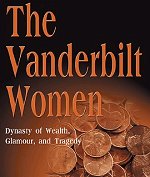 The Vanderbilt Women: Dynasty of Wealth, Glamour and Tragedy The fascinating lives of three generations of Vanderbilt women who dominated New York society from the middle of the eighteenth century through the twentieth. Of special interest are the discovery of unpublished letters |
Women of the American Suffrage Movement
Womens Suffrage Timeline
American Civil War Women
Womens Civil War Reading Titles
American Civil War Recipes
Civil War Exhibits
Dora Lewis (center) of Philadelphia [with Clara Louise Rowe (left) and Abby Scott Baker (right)] on release from jail after days of hunger strike. August 1918.

The day after the police announce that future pickets would be given limit of 6 mos. in prison,
Alice Paul led picket line with banner reading "The time has come to conquer or submit for there is but one choice - we have made it."
She is followed by Mrs. Lawrence Lewis [Dora Lewis]. This group received 6 mos. in prison.
click to enlarge photo

Left to right: Adelaide Johnston, sculptor, Mrs. Lawrence [Dora] Lewis, Phila., Jane Addams. At time statue was placed in capitol.

 Woman Suffrage and the New Democracy The woman suffrage movement achieved its goal by forging a highly organized and centrally controlled interest group, the National American Woman Suffrage Association (NAWSA), one of the most effective single-issue pressure groups in the United States |
 From Equal Suffrage to Equal Rights: Alice Paul and the National Woman's Party, 1910-1928 The woman's movements and work in American history was dramatic. It dealt with the past, with pageants and politics; with organizations and with conflict from within |
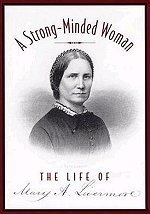 A Strong-minded Woman The Life of Mary Livermore A leading figure in the struggle for woman's rights as well as in the temperance movement, she was as widely recognized during her lifetime as Susan B. Anthony, and for a time the most popular and highly paid female orator in the country |
Kindle Available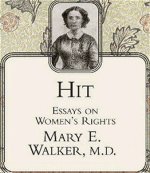 Hit: Essays on Women's Rights by Mary Edwards, M.D. Walker The only woman to receive the Congressional Medal of Honor for her service during the Civil War, Dr. Mary E. Walker (1832-1919) was a surgeon, a public lecturer, and an outspoken champion of women's rights. One of the first women in the country to be awarded a medical degree, she served as an assistant surgeon for the Fifty-second Ohio Infantry |
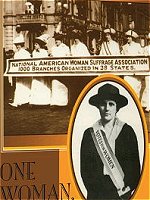 One Woman One Vote This program documents the struggle which culminated in the passing of the 19th Amendment in the U.S. Senate by one vote. Witness the 70-year struggle for women's suffrage. Discover why the crusaders faced entrenched opposition from men and women who feared the women's vote would ignite a social revolution. DVD |
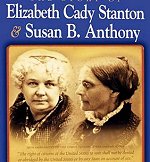 Not for Ourselves Alone: The Story of Elizabeth Cady Stanton & Susan B. Anthony Together they fought for women everywhere, and their strong willpower and sheer determination still ripples through contemporary society. Here lies the story of two of our century's most celebrated pioneers Elizabeth Cady Stanton and Susan B. Anthony. DVD |
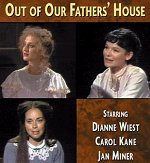 Out of Our Fathers House Broadway Theatre Archive This play presents the true stories of women who sought independence at any cost. The compelling text is taken entirely from the diaries, journals and letters of the characters portrayed. |
Sources:
U.S. Library of Congress
Federal Citizen